Why Attend an ASCSA Summer Session?
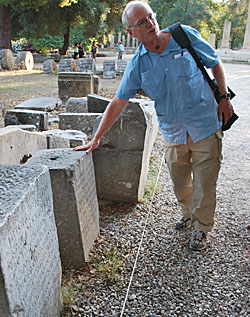
Co-Leader Tim Winters discussing the inscriptions at Olympia
Eleni Hasaki, Associate Professor, School of Anthropology and Department of Classics at the University of Arizona, and Timothy F. Winters, Professor of Classics at Austin Peay State University, ably led the School’s Summer Session in 2009. Recently, the School asked them to outline those aspects that they felt made the School’s Summer Session a standout study-abroad program. Their responses (accompanied by snapshots of their session) are below.
An Intensive Tour of Greece: Six Weeks, 100+ Sites and Museums
The schedule is demanding—over 100 sites and museums and coordination with over 60 American, Greek, German, French, and Danish archaeologists! At the end of it, we were tired but in the best possible way, worn out with the pleasure of having accomplished a physically and intellectually demanding program. To visualize the scope of our travels, Richard Davis, a Classics teacher at Hotchkiss School, Connecticut, who participated in the session, tracked our visits to every site on a Google Map page. (See also Richard Davis’s blog for a running account of the 6 week tour.)
Where in the World is Summer Session?
Small and Varied Group
The 20-member group consisted of 9 undergraduates, 6 graduates and four high school teachers, recipients of a Fulbright fellowship and an Associate Professor of English at DePauw University. The schools in which the students were enrolled represented the entire geographical scope of the U.S., from Harvard University and University of Virginia in the East, to Ohio University and University of Chicago in the Midwest, and on to University of Arizona and University of Texas at Austin in the West. The geographical and age differences gave a unique flavor to the group.
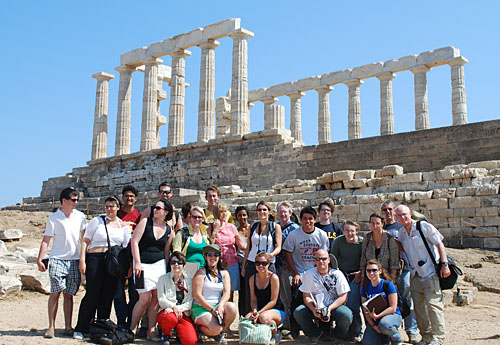
At Poseidon’s Temple in Sounion with Dr. Aileen Ajootian
“Behind the Ropes” Experiences
The Summer Session is unlike any other summer program in the Mediterranean, not only for its duration and intensity, but also for the quality and quantity of scholars who are invited to lead on-site visits. The students in the Summer Session enjoy rare opportunities to visit sites that are closed to all other visitors; even scholars have to ask special permission to enter such areas as the interior of the Parthenon, the workrooms on the Acropolis where restoration and restudy take place, and the storerooms of many excavations that hold unpublished material. The speakers are the directors of the sites, or scholars with international reputations in the field. Over 60 scholars this year took precious time from their research agendas to discuss everything from the shapes of architectural moldings to the poetry of Kavafis, with stops along the way at Schliemann’s notebooks, Michael Ventris’ letters, processions in the palace at Tiryns, and many other places too numerous to mention. Such participation is the norm for the Summer Session.
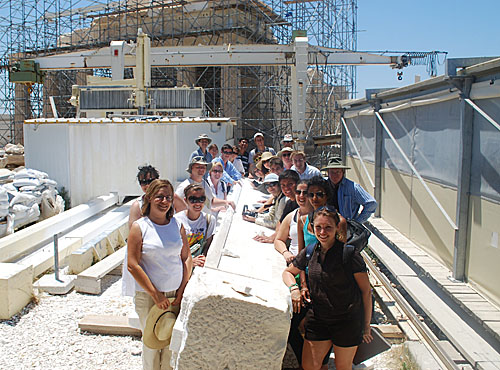
Behind the scenes: at the Parthenon restoration
Partnership with the Fulbright Teacher Exchange Program
The ASCSA has a long standing collaboration with the Fulbright Foundation through the Fulbright Teacher Exchange Program to enable high-school teachers to attend the Summer Sessions. In our group, we had four Fulbright teachers. All of the secondary school teachers offered a synopsis of how they might put the information they had acquired to work in their classrooms. They presented brief lesson plans and that discussion was in itself educational for the entire group. A Fulbright secondary school teacher, Jennifer Carinci (currently a Ph.D. candidate in Education at Johns Hopkins University) kept an amazingly illustrated scrapbook, capturing places, people, monuments! Joel Cook, an Art Educator in Reagan High School in Houston) has already put into practice his knowledge and created a list of books for AP Art History teachers for Greek sources.
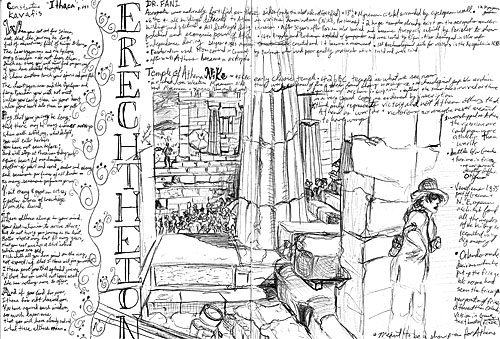
A page from Jennifer Carinci’s scrapbook.
Education for the Leaders, too
The ASCSA Summer Session holds exciting moments even for the directors, who typically are frequent visitors of Greece and have a deep knowledge of its monuments. Dr. Winters is a veteran of study abroad tours and it was his second time leading the Summer Session (2000); he was mesmerized by the pottery sherds with very early Greek inscriptions that we saw one afternoon at the workrooms of the site of (northern) Methone. I (Dr. Hasaki) visualized how narrow Greek temples are, by lining up three students with outstretched arms inside the cellas of Temple of Aphaia on Aegina and the Temple of Apollo Epikourios at Bassae
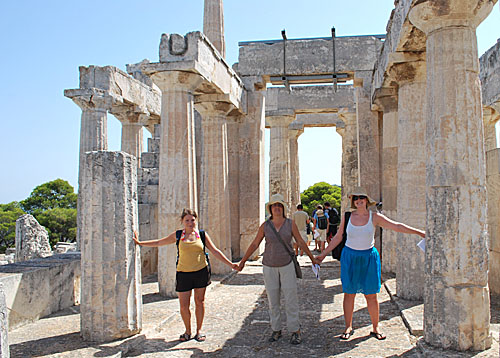
Measuring up the Temple of Aphaia on Aegina (Eleni Hasaki in center)
Full Organizational Support of the School
The work of running the Summer Session begins about one year in advance and proceeds with the help of the Committee on the Summer Sessions. While in Athens, students have their meals and accommodations on the ASCSA campus, and thus have ample opportunity to interact with scholars, many of whom use the ASCSA library as a base for their summer research. These professional relationships, established early in the careers of the participants, are pivotal in their later graduate and professional careers. The arrangements are facilitated by the extremely helpful staff in Athens. Even our driver for most of the trips, proved to be an enormous help and taught us much about various aspects of Greece. He knew the roads of Greece, and was possessed of a quick, sharp wit that got us through some long days. He was a great help in finding good places to stop for meals as well! Once again, such attention to the well-being of the students is typical of the degree to which the School is invested in the Summer Sessions.
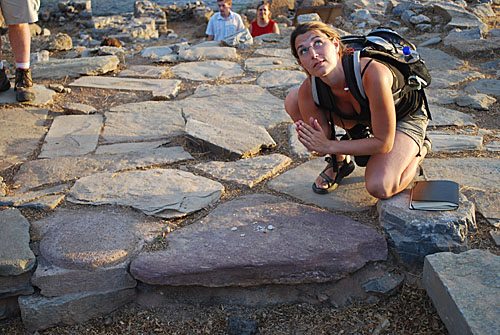
Participant Meredith Bullard making an offering at Mochlos
Unique Experiences
There were many firsts and many gripping moments for this Summer Session: the first Greek female director of a Summer Session; first group to enter the metals vault at INSTAP; first group to visit Azoria with Excavation Director Donald Haggis; first to visit the new excavations at Methone; first to have a speaker from the DAI at Olympia; first to have a speaker from the French School at Mallia; first to have the education director of the Thessaloniki museum as a guide for the collection. We were all happy to be a part of so many great moments. One event stands out, the memory of which will remain strong for years to come. That was the joy of meeting Professors Joe and Maria Shaw on site at Kommos. Joe Shaw provided us with a fine introduction to the site beneath the stand of trees to the north-east of the site, and Maria Shaw walked us through, patiently answering many questions along the way. Their deep knowledge of and love for the site are a source of inspiration to us all. Other highlights of the trip were swimming the straits at Mochlos on Crete, hiking through the middle of Mt. Parnassos, stopping to see the crossroads where Oedipus was meant to have killed Laius, and visiting the cult center at Mycenae. Both students and directors have now a rich photographic archive which they turn to for classes, research, and education outreach to our communities.
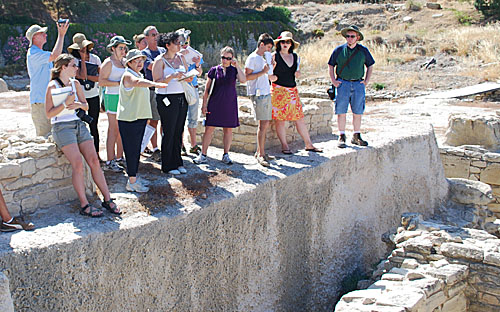
Dr. Maria Shaw showing the group around the site of Kommos
Ancient and Modern Greece Side by Side
One aspect of the School that does not receive as much attention as it might is its strength in presenting Modern Greece side by side with the ancient monuments. Daily readings from Greek poetry proved eye opening for many who had no prior contact with the literature of modern Greece. Other experiences reinforced the importance of learning about the modern country. We were fortunate to have the Mayor of Dhistomo, who lost relatives in the 1941 massacre, address us in the newly opened museum to the WW II atrocities. We were also fortunate to hear Frosso Charitou in Arachova discuss aspects of modern Greek weaving techniques and associations of craftswomen. Many of the students attended a lecture on the Greek Revolution and heard Professor Alan Boeghold read some of his translations of Kavafi, listened to Cretan mantinades with their intricate meter, and spent a good deal of time discussing modern Greece. The visit to the modern first National Cemetery where some ASCSA former members are buried, raised the comparison to the ancient Kerameikos; modern quarries, and workshops in marble and pottery also led to comparisons with ancient quarries and workshops. This facet of the ASCSA Summer Session is certainly one of the finest aspects of the program, and is perhaps the one most difficult to find on any other similar program.
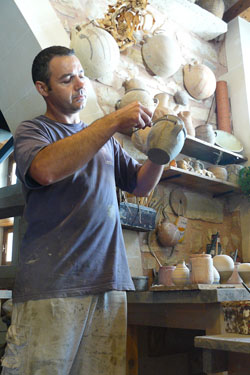
A traditional potter explains his technique on Crete
Immersive Learning
The students are required to give two site reports. The topics are distributed well in advance so that students can complete their research in their own institutions prior to arrival, and then finalize them at the ASCSA’s Blegen and Gennadius Libraries. Being in Athens also provides the students access to the libraries of the British School, the French School, and the German Archaeological Institute. After each trip outside of Athens, we held a debriefing session in which we went through the sites geographically and chronologically. The students found those sessions quite helpful in terms of tracking the huge amount of information that was presented.
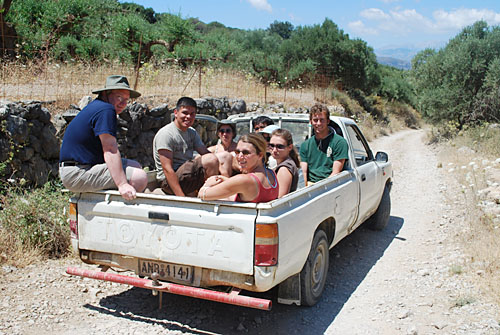
Hitting the road to the Azoria Excavations
Summing It Up
The ASCSA Summer Session offers something profoundly important for all who participate. All participants acquire an appreciation of culture in a context rather than in a textbook. They learn what challenges face a country with such a rich heritage trying to progress in contemporary society. All participants also gain a 3-D understanding of the ancient world. Without having to navigate the mountains and seas of Greece, it is difficult to understand how important a factor geography is for ancient history. Those who continue in Classics often come back, apply to the Academic Year Program, finish their dissertations at the ASCSA, and may even ultimately decide to lead a Summer Session themselves.